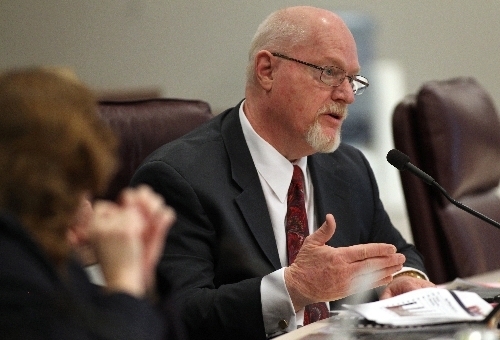Public Employees Retirement System review finds plan healthy

CARSON CITY – An independent assessment of Nevada’s public employee pension plan set for review Wednesday gives the retirement program good marks, suggesting its unfunded liability will decline over the next 30 years, requiring lower taxpayer-backed contributions to keep fiscally healthy.
Using the current assumptions for the plan, including an 8 percent annual return on investments over the long term, the plan will be 100 percent fully funded, the report obtained by the Review-Journal says.
The report by AonHewitt, which compares the Public Employees Retirement System to other comparable public pension plans around the country, also found that the plan’s actuarial funding policy is “best-in-class.”
“In summary we believe the NVPERS Actuarial Funding Policy is comprehensive, thoughtful and a model for other public retirement systems to follow,” the report says.
But the $50,000 review, which was sought by Gov. Brian Sandoval before he would consider the possibility of major changes to the plan, does show the potential risk if a major assumption of the plan does not materialize. That assumption is that the plan will see an 8 percent return on its investments in stocks, bonds and other financial instruments over the next 30 years.
The current $11.2 billion long-term unfunded liability in Nevada’s plan would increase to $25.4 billion if the plan realizes only a 6 percent return, the analysis shows.
A larger unfunded liability would require higher contribution rates to the plan, taking general fund tax dollars that could be used instead for public education or other needs.
Assemblyman Randy Kirner, R-Reno, has proposed changing the plan for future public employee hires to include a defined contribution element which would create no long-term financial liability to state and local governments and thus taxpayers.
The current defined benefit plan, which pays retirement based on years of service and salary, does bring with it an obligation on the part of the state and local governments to keep it financially healthy.
That has required an increasing government contribution rate on behalf of each worker. State employees pay half of the contribution rate, but some local government workers contribute nothing at all due to collective bargaining agreements.
Kirner said the study is more of a big picture overview and does not address the question of whether an 8 percent investment return is realistic years into the future. It won’t do anything to further the discussion about the need for reforms, he said.
“I guess the upshot is that when PERS is compared to other plans we end up being pretty well situated,” Kirner said. “But the fact of the matter is that many other plans are in the same kind of trouble we’re in. Our liabilities are growing, our contribution rates are going up and at some point you have to ask if it’s sustainable.”
The contribution rates now total 25.75 percent of a regular public employee’s salary, and 40.5 percent of salary for those in the police and firefighter plan.
If retirement system assumptions hold true, those rates 30 years from now will be 17.5 percent for regular employees and 30 percent for police and fire, the report says. But Kirner said those rate reductions would not be seen for many years.
Kirner said he plans to again pursue changes to the state retirement system in the 2015 legislative session if he wins re-election.
Craig Stevens, director of government relations for the Nevada State Education Association, said the report suggests there is little foundation for critics who want to make wholesale changes to the defined benefit plan.
“PERS is well run,” he said. “It is one of the better systems in the country.”
The Legislature in 2009 enacted several changes to the plan that have helped make it financially stronger, and the report is a reaffirmation of that effort, Stevens said.
“We want to make sure the defined benefit pension remains for our members and will be there 30 or 40 years from now,” he said. “It is a piece of the puzzle that attracts educators into the field.”
The report will be reviewed by the Public Employees Retirement System board on Wednesday and will likely be a point of discussion for those who want to keep the current plan and those who want to change it for future public sector workers to a defined benefit plan, which would more closely mirror the 401k-type plans in place for many private sector workers.
The retirement system’s rate of return on investments has exceeded the 8 percent benchmark for the past 29 years through June 30, 2013, averaging 9.3 percent. But there are significant fluctuations from year to year.
The retirement fund saw a 12.4 percent increase in value in the fiscal year that ended June 30, bringing the total assets to $28.7 billion. The plan also saw a record 21 percent return in Fiscal Year 2011, but suffered a 15.8 percent loss in Fiscal Year 2009, for example.
The Public Employees Retirement System Board in September reviewed the assumptions used for the plan and voted to maintain the rate.
One factor that is unusual for the retirement plan is that public sector workers do not contribute to Social Security, making it a more important component of retirement than it would be otherwise.
Contact Capital Bureau reporter Sean Whaley at swhaley@reviewjournal.com or 775-687-3900. Follow him on Twitter @seanw801.
2013 NVPERS Independent Comparable Study.pdf












